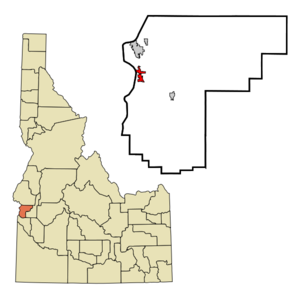- Fruitland, Idaho
Infobox Settlement
official_name = Fruitland, Idaho
settlement_type =City
nickname =
motto =
imagesize =
image_caption =
image_
imagesize =
image_caption =
image_
mapsize = 250px
map_caption = Payette's location withinIdaho
mapsize1 =
map_caption1 =subdivision_type = Country
subdivision_name =United States
subdivision_type1 = State
subdivision_name1 =Idaho
subdivision_type2 = County
subdivision_name2 = Payette
government_footnotes =
government_type =
leader_title =
leader_name =
leader_title1 =
leader_name1 =
established_title =
established_date =area_footnotes =
unit_pref = Imperial
area_magnitude =
area_total_km2 = 3.9
area_land_km2 = 3.9
area_water_km2 = 0.0
area_total_sq_mi = 1.5
area_land_sq_mi = 1.5
area_water_sq_mi = 0.0population_as_of = 2000
population_footnotes =
population_total = 3805
population_density_km2 = 970.0
population_density_sq_mi = 2512.2timezone = Mountain (MST)
utc_offset = -7
timezone_DST = MDT
utc_offset_DST = -6
elevation_footnotes =
elevation_m = 679
elevation_ft = 2228
latd = 44 |latm = 0 |lats = 58 |latNS = N
longd = 116 |longm = 55 |longs = 17 |longEW = Wpostal_code_type =
ZIP code
postal_code = 83619
area_code = 208
blank_name = FIPS code
blank_info = 16-28990
blank1_name = GNIS feature ID
blank1_info = 0396521
website =
footnotes =Fruitland is a city in Payette County,
Idaho ,United States . It lies alongU.S. Route 95 in theTreasure Valley of southwest Idaho, about 50 miles west of Boise and near the border withOregon . Fruitland is named after the apple orchards that surround the community, and its slogan is "The Big Apple of Idaho."As of the 2000 census, the city had a total population of 3,805. It is part of the Ontario, OR–ID Micropolitan Statistical Area.
Geography
Fruitland is located at coor dms|44|0|58|N|116|55|17|W|city (44.016035, -116.921450),GR|1 within the
Snake River watershed.According to the
United States Census Bureau , the city has a total area of 1.5 square miles (3.9 km²), none of which is covered by water.Demographics
As of the
census GR|2 of 2000, there were 3,805 people, 1,378 households, and 1,044 families residing in the city. Thepopulation density was 2,512.2 people per square mile (972.9/km²). There were 1,518 housing units at an average density of 1,002.2/sq mi (388.1/km²). The racial makeup of the city was 87.70% White, 0.89% Asian, 0.60% Native American, 0.05% African American, 0.03% Pacific Islander, 8.02% from other races, and 2.71% from two or more races. Hispanic or Latino of any race were 17.92% of the population.There were 1,378 households out of which 40.6% had children under the age of 18 living with them, 58.1% were married couples living together, 13.1% had a female householder with no husband present, and 24.2% were non-families. 21.4% of all households were made up of individuals and 10.6% had someone living alone who wais 65 years of age or older. The average household size was 2.76 and the average family size was 3.20.
In the city the population was spread out with 31.9% under the age of 18, 9.0% from 18 to 24, 27.6% from 25 to 44, 18.6% from 45 to 64, and 12.9% who were 65 years of age or older. The median age was 31 years. For every 100 females there were 93.8 males. For every 100 females age 18 and over, there were 87.3 males.
The median income for a household in the city was $32,469, and the median income for a family was $36,614. Males had a median income of $31,419 versus $22,000 for females. The
per capita income for the city was $14,488. About 8.3% of families and 11.9% of the population were below thepoverty line , including 15.6% of those under the age of 18 and 14.0% of those 65 and older.References
External links
* [http://fruitland.org/ City of Fruitland]
* [http://fruitlandidaho.org/ Fruitland Chamber of Commerce]
Wikimedia Foundation. 2010.


